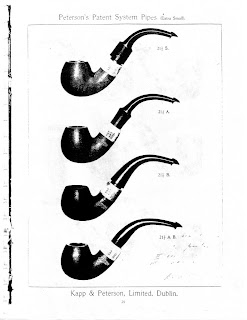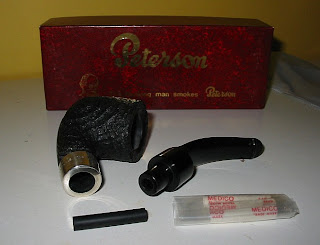
In the past I tried, not particularly successfully, to devise a detailed method of categorising snuffs, in the interest of making things rather clearer for newcomers to the world of snuff, but as time passes I find that the traditional method of classifying snuff is almost certainly easier and clearer for everyone. An obvious case of there being no reason to reinvent the wheel!
Professor Phillips Griffiths presents
on his web site a simple and straightforward system of categorising snuffs: "
Snuffs vary from moist to dry, and from coarse to fine (gros, demigros, and fin) and may be natural or perfumed or medicated." This suffices perfectly well for most purposes, indicating the broad characteristics of a snuff.

However, the traditional way of describing snuff as being
fin,
demigros or
gros does have a drawback in that the
French term gros implied dark, moist and coarse while fin suggested pale coloured, dry and finely ground. This usually works well enough for European snuffs but is not always suitable for describing other snuffs. Finely ground moist, dark snuffs and coarsely ground pale, dry snuffs are by no means unknown.
My suggestion would therefore be to avoid the use of the French terms and instead use appropriate English terms.
Moisture | Dry - Medium - Moist |
Grind | Fine - Medium - Coarse |
Flavour | Plain - Medicated - Scented |
Colour | As appropriate |

Flavour is the most awkward part of any sort of categorisation of a snuff.
Snuffs can be flavoured in various different ways but essentially there are three different methods. In the most common method these days, the snuff is flavoured after grinding with suitable essences. In the now less common method the tobacco is flavoured before grinding, the rolls or twists of tobacco being steeped in an appropriately flavoured "sauce". Yet other snuffs gain their flavour not by sauces or essences but by the methods of fermentation and the blending of different tobaccos. The latter would be a plain snuff rather than a scented one.
Plain snuffs have no extra flavouring and come in various grinds and can be simple plain snuffs, like old fashioned rappees, plain SPs and American scotches or the results of blending and fermentation of different tobaccos, like some of Bernard's non-Schmalzler snuffs. Some plain snuffs can also be toasted or smoked. These are traditional in the western parts of the British Isles, in Ireland, western Scotland, Wales and the United States. They are fine, dry and usually pale in colour. They are known as Irish High Toasts or High Dry Toasts if oak is used in the process and American plain or strong scotches if hickory is used. It has been suggested that toasts are toasted before they are ground up and scotches are smoked after they are ground up.
Medicated snuffs seem to be traditionally English but are now produced elsewhere and are very popular. Menthol is the most common flavouring but camphor, eucalyptus and pine oil are also frequently used. Medicated snuffs can also be scented.
Scented snuffs are possibly the most popular internationally these days and a huge variety of floral scents, fruit flavours, herbs, spices, perfumes and essences is used in the manufacture of these snuffs. Some toasted snuffs can also be lightly scented as can many . Perhaps the most common scent used in the manufacture of snuff is bergamot, a citrus fruits from southern Italy, which provides the traditional flavouring in a scented SP.
Traditional Snuff Styles
It is worth mentioning various distinct national or regional snuff styles. These are readily defined as above but deserve a few notes.
Schmalzler is a traditional Bavarian style of snuff, usually made from Brazilian tobacco, which gets its flavour from the sauces used before grinding. They range from the relatively plain to the highly flavoured. Different degrees of fermentation give rise to the variety and depth of the flavours. Some are now mentholated.
Scotch is an American style of snuff, originally derived from the Irish and Scottish toasted snuffs but having a distinctive character of its own. Scotches are always very finely ground, and can be plain, strong or sweet. The strong scotches are the ones with the smoky flavouring. Sweet scotches often have fruit flavouring.
SP snuffs are traditionally English and now usually have some measure of citrus flavouring, usually but not exclusively of bergamot. PhilipS's comments are worth quoting on the subject of SPs:
"SP might cause a problem (for classification) because definitions vary. For many years SP was associated with the Sheffield mills of Westbrook and Sharrow. SP was thought of as a plain golden-brown medium snuff until Sharrow changed the name of Queens to Best SP. Thereafter SP (in my opinion) is associated either with a plain medium snuff (SP No. 1) or one using oil derived from the peel of Citrus Bergamia which is exclusive to Reggio-Calabria in southern Italy. The top note is lemon leaving a lingering scent similar to neroli. It blends very well with lavender which is also used in the these Sharrow blends. This could be called Piquant SP as opposed to just SP (Plain SP). (Samuel Gawith call these ‘Scented SP’ and ‘Plain SP’ respectively.) Interestingly in the past the dried peel was made into snuff boxes and the oil used to flavour gin as well as snuff and tea."
I would love to receive input from others on this subject.
My latest self-indulgence... A Patrick Collins Oak Triple Tech snuff box.

























